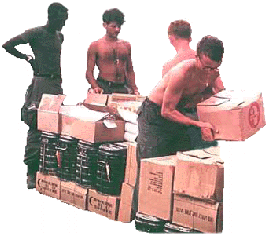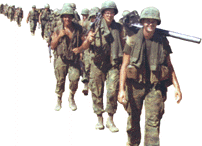We weren't the only ones in Vietnam who used high explosives.
Charlie used them, too. And his could be just as effective as ours. As the new
fire support base on the block, Patton II became the target of a VC demolition team.
Their objective was to cut our line of supply, by mining the road between Bau Dieu and the
base.
On their initial attempt we lost two supply trucks and a jeep. The first
explosion went off while we were filling sandbags. Before we could put our tools
down we heard a second explosion. Immediately a relief column went out to help the
drivers. We quickly marched the half mile to the site of the explosions. Both
truck drivers had been seriously hurt by metal fragments. The trucks were a
shambles. Tires, axles, fenders - their entire front ends had been twisted back.
The explosive force of the mines was substantial.
Mine sweepers came out to check the rest of the road. For an hour and a half they
went inch by inch along that entire strip. Their meters registered nothing but
fragments from the demolished trucks. They declared the road safe. A wrecker
came to pull the debris away, and when the road was clear, the waiting convoy continued
its journey to Patton II. The company first sergeant led the way in a jeep.
Just beyond where the trucks had hit the mines, the jeep leaped into the air as a third
mine went off with a boom. The sergeant was injured, but not killed. Sandbags
on the floor of the jeep had protected him from the shrapnel.
Every night the enemy placed new mines and every day they claimed more vehicles.
We had a ringside view from the new fire base. It quickly fell into a routine:
send out a minesweep team to check the road, declare the road safe, and wait for some
unlucky vehicle to hit the first mine. On some days they even swept the road
twice. Nor was it always the first vehicle that got hit. It could be the
second, or tenth. Just as you'd expect, some guys even started wagering how many
trucks would make it before the next one bit the dust. One thing was certain.
Before the day was out, another vehicle would go up in smoke.
The night after the first convoy attack, we began nightly ambush patrols. Yet our
patrols turned up nothing. We saw nothing, we heard nothing. And so we
accomplished nothing. The mines magically appeared each day. The men putting
them there had to be doing it right under our noses.
 It was two weeks before we got a break in the case. First
platoon was searching the hootches north and west of the fire
base, about three kilometers out. As they approached a cluster of hootches, they
heard a muffled explosion. The men surrounded the buildings and moved in.
Smoke was drifting from the door of a hootch. Inside was a hole in the floor - there
had been a trap door, but it was gone now. Two bodies lay on the floor of a bunker
hidden beneath the hootch. It was a bomb factory. The two men had been
constructing another mine for the nightly war effort when it went off on them. Our
hopes rose. Perhaps the mining was over. The next day we waited expectantly
to see if any new explosives had been planted. Around noon it happened.
Another truck hit a mine.
It was two weeks before we got a break in the case. First
platoon was searching the hootches north and west of the fire
base, about three kilometers out. As they approached a cluster of hootches, they
heard a muffled explosion. The men surrounded the buildings and moved in.
Smoke was drifting from the door of a hootch. Inside was a hole in the floor - there
had been a trap door, but it was gone now. Two bodies lay on the floor of a bunker
hidden beneath the hootch. It was a bomb factory. The two men had been
constructing another mine for the nightly war effort when it went off on them. Our
hopes rose. Perhaps the mining was over. The next day we waited expectantly
to see if any new explosives had been planted. Around noon it happened.
Another truck hit a mine.
The next night we had our second break. Just before dawn, while it was still
pitch black, our lookout spotted movement near the road. His starlight scope showed
two men right on the road, bending over and working on something. We radioed another
ambush patrol on the other side of the road and alerted them we were about to open fire.
Weapons were readied. One of the RTO's broke out a
flare to illuminate the road and give us a target to shoot at. When all was ready
the lieutenant gave the signal.
The man with the flare pulled off the cap, placed it onto the bottom of the metal tube,
and slapped it with his open palm. In his excitement, he concentrated too hard on
firing and forgot to look where he was aiming. The flare burst from the tube and
raced into the night - about two feet off the ground and straight for the men on the road.
The flare bounced off the crest of the road and continued into the dark, burying
itself in the rice paddies beyond.
So much for the element of surprise. We opened fire. The trouble with night
action is that you have no target. While it seems as if you are shooting straight
out, the fire can be high or low and there is no way to tell. We didn't have tracer
rounds in our M-16s. How close we came we never knew.
I'm sure the two men took off crawling as soon as the rocket was fired and since
they were beyond the crest of the road, our shots could have no effect. Our other
squad was almost directly opposite us. Rather than supply a cross fire, they buried
their heads in the dirt and hoped to escape unscathed.
Now dawn broke over the horizon. The sky lightened and we rose from our position
to investigate the ambush site. There was little sign on the road of enemy activity.
A few footprints confirmed that we had indeed seen something. I walked over
to a handkerchief I saw lying in the dirt and was just about to pick it up when I was
yanked back. I turned to look into the face of 1Lt. Tom Deutschlander, who had me by the
shoulder. "Ramsey, that's where the mine is!" he said. It was his
handkerchief! One more step and I might have become the first pedestrian mine
casualty.
Two squads spread out and searched for signs that we had hit the men. The rest of
us carefully began digging up the mine. The dirt was still loose, so it came out
easily. Soon we saw the nature of the weapon being used. The mine was just a
big blob of plastic explosive, shaped in a 3 lb. coffee can and then removed. A
blasting cap had been inserted into the bottom, and the wires went to a small battery
placed beneath the mine in the hole. Two narrow bamboo sticks, separated by thin
pieces of bamboo and wrapped with bare wire, made up the detonator. The pressure
from a truck driving over them would force the two slats together, completing the circuit.
There was almost no metal involved - that was the beauty of it. The small
amount of metal necessary, the battery and blasting cap, were buried a foot below the
surface. That explained why our sweep teams found nothing. The daily buildup of
scrap metal blasted into the dirt road camouflaged the mines. The metal detectors
never had a chance. We still had not caught the men responsible for the mines.
But we were getting closer. It was to be only a matter of days before the mining
stopped - but not so easily as we expected.
